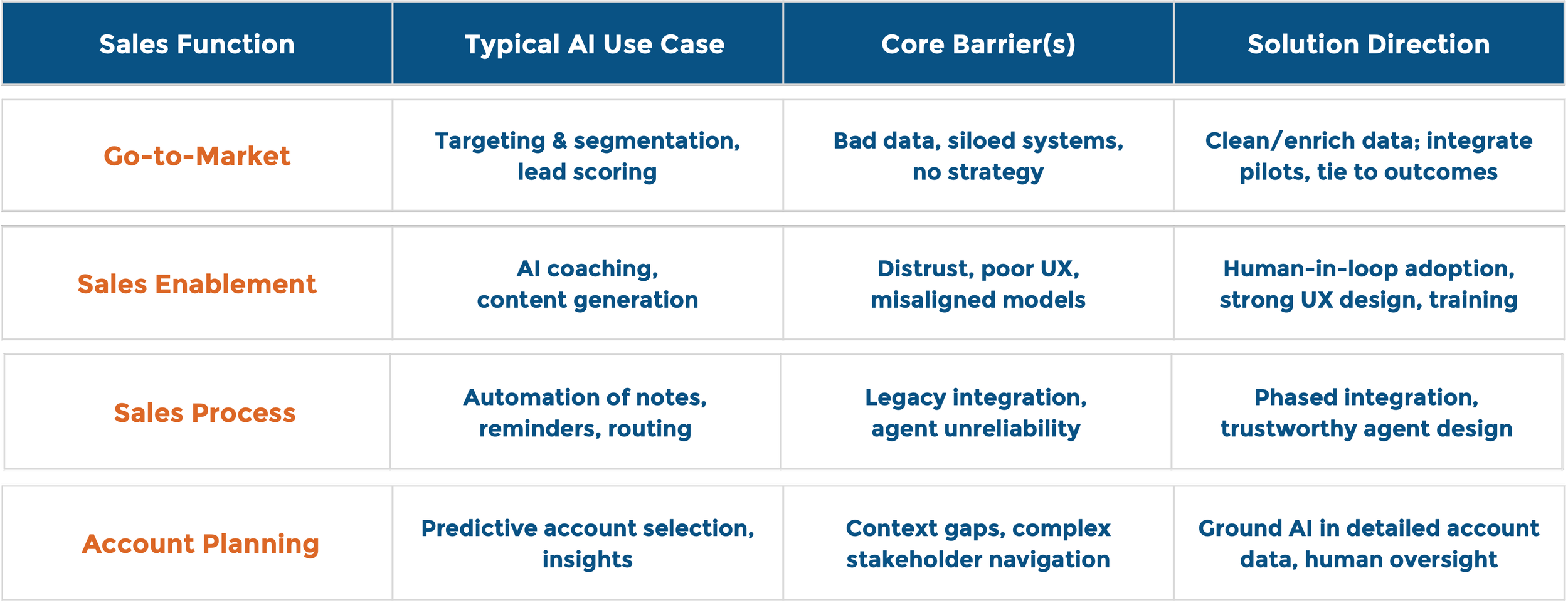AI Enabled Enterprise Sales Use Cases: 6 Key Barriers to AI Sales Adoption at Scale
Enterprise technology sales companies and global consulting firms often struggle to implement AI and AI agents for Go-to-Market (GTM), Sales Enablement, Sales Process, and Account Planning due to a combination of organizational, data, process, and cultural challenges.
Here’s an overview of the key barriers to AI Sales Adoption at Scale:
1. Data Challenges
Fragmented and Siloed Data
Sales data is often spread across multiple CRMs, marketing automation tools, ERP systems, and spreadsheets, making it difficult for AI to have a unified view.Poor Data Quality and Completeness
Missing, duplicate, or inaccurate account, contact, and opportunity data undermines AI recommendations.Lack of Contextual Data
AI agents require firmographic, technographic, buyer intent, and historical engagement data, which may not be integrated or accessible.
2. Process Complexity and Misalignment
Non-standardized Sales Processes
Large global firms often have multiple sales methodologies (MEDDPICC, Value Selling, Solution Selling), making AI orchestration challenging.Complex Account Planning Structures
Enterprise accounts often involve dozens of stakeholders, multi-year deal cycles, and multiple solution areas, complicating AI automation.Disconnect Between Marketing, Sales, and Delivery
AI insights for GTM and account planning lose value if marketing, sales, and consulting teams operate in silos.
3. Organizational and Cultural Resistance
Low Trust in AI Recommendations
Seasoned sales executives and partners often rely on relationships and intuition, not AI-generated insights.Fear of Job Displacement or Oversight
Sales teams may see AI as a tool for micromanagement or replacement rather than enablement.Change Management Complexity
Integrating AI agents requires behavior change, new workflows, and training that global teams may resist.
4. Technology and Integration Barriers
Legacy Systems and CRM Limitations
AI often struggles to integrate with older CRMs or custom-built systems used by large consulting firms.Scalability Issues
Pilots may work in a single geography or business unit, but global rollout requires harmonized data and governance.Limited AI Agent Orchestration
Many companies implement point solutions (chatbots, lead scoring, or proposal generators) without an end-to-end AI agent strategy.
5. Strategy and ROI Uncertainty
Lack of a Clear AI for Sales Framework
Companies often try isolated AI use cases without mapping them to the sales stage-gate process or business outcomes.Difficulty Measuring Impact
AI-driven account insights or pursuit recommendations are hard to tie directly to revenue lift or shorter sales cycles.Short-Term ROI Pressure
AI investments in sales often require 12–24 months to show impact, which conflicts with quarterly sales pressure.
6. Emerging AI Capabilities vs. Sales Reality
AI Agents Need Contextual Knowledge
Generative AI can create content, but it struggles with account-specific nuances without well-structured knowledge bases.Dynamic Market and Buyer Behavior
AI models can lag behind shifts in buyer priorities, industry trends, or competitive landscapes.Compliance, Privacy, and IP Concerns
Sharing sensitive client information with AI systems raises legal and reputational risks, especially in consulting.
Summary
Global technology and consulting firms struggle because AI for sales is not just a tech problem—it’s a data, process, culture, and strategy problem. Without clean data, standardized workflows, trust in AI outputs, and an integrated AI agent strategy, adoption remains slow and fragmented.
Cagle Consulting Partners works with Global Sales and Consulting leaders to unlock the potential of AI, at scale, within Enterprise Go to Market and Sales efforts.

